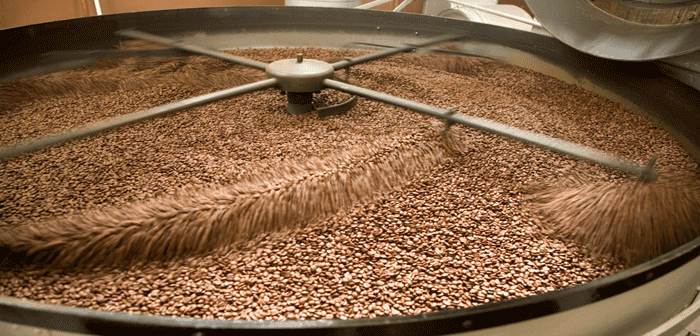Issues of wood as fuel
The problem with using ordinary woody biomass is that it has low calorific value, often has high moisture content and is pretty low in terms of energy density. Apart from the low combustion efficiency, woody biomass is too bulky for economical transport over any long distance. Wood is also difficult to grind (pulverize) and absorbs moisture during storage. High moisture content in woody biomass reduces the efficiency when being fired and leads to an increase in fuel costs. This all adds up to woody biomass being inferior as a fuel when compared to coal.
Torrefaction
Torrefaction as a process is not a new technology and coffee beans have been torrefied for centuries. In the French language, a producer of coffee is called a “torrefacteur”.
An option to make woody biomass more suitable as a fuel for both household and industrial use is to pre-treat the biomass. Torrefaction is the thermo-chemical treatment process of biomass material which occurs when material is heated between 220 to 320 °C (428 – 572 °F). The ‘roasting’ process or mild pyrolysis takes place at atmospheric pressure and in a low oxygen environment.
The water in the biomass and other volatile organic compounds (VOCs) are driven off during the torrefaction process. The VOCs and hemicellulose combust and assist in providing heat to the process. What remains is a product that is solid, dry, and blackened which is called “torrefied biomass” or “bio-coal”. The final product repels water, won’t rot and can be stored in moist air or rain as opposed to the original woody biomass it is made from.
Higher energy content
During torrefaction the biomass dries out and partially de-volatizes, so there is significant reductions in weight while the energy content only drops slightly (ca. 10%). For example, the weight of the biomass can be 60-70% of the original mass, although the energy density can increase by up to 30%.
Torrefaction helps develop a more uniform feedstock as it can be pulverized and made into briquettes or pellets. “Densification of torrefied material reduces specific energy consumption and increases throughput by a factor of 2 compared to raw or untreated biomass” (*Industrial Biotechnology, 2011).
As mentioned earlier, “A key advantage of the reduced mass and increased energy value of torrefied wood is the impact on transportation. A typical payload for a load of green chips is approximately 25 tons, or 50,000 lbs. Using an energy value of 4,500 Btu/lb (green weight), a load of green wood chips would contain 225 MMBtu. By comparison, when transporting a torrified wood product, the energy value of a 25 ton load could be 478 MMBtu, depending on the feedstock and torrefaction process used. By transporting a higher-valued product, the costs to transport energy (measured in BTUs) are decreased. Another consideration for the reduced mass is that storage space would be less for torrefied wood versus green chips” (*Torrefaction What’s that, Fueling the Future 2010).
Torrefied biomass has been successfully used as a solid fuel in firing gasification power plants. However, there doesn’t appear to be very many large scale conversion plants, and we do need to ask the question… is the product really sustainable?
* See Torrefaction Downloads section

